
Bellis perennis, the daisy, is a European species of the family Asteraceae, often considered the archetypal species of the name daisy. To distinguish this species from other plants known as daisies, it is sometimes qualified as common daisy, lawn daisy or English daisy.

Diselma archeri is a species of plant of the family Cupressaceae and the sole species in the genus Diselma. It is endemic to the alpine regions of Tasmania's southwest and Central Highlands, on the western coast ranges and Lake St. Clair. It is a monotypic genus restricted to high altitude rainforest and moist alpine heathland. Its distribution mirrors very closely that of other endemic Tasmanian conifers Microcachrys tetragona and Pherosphaera hookeriana.

Drosera peltata, commonly called the shield sundew or pale sundew, is a climbing or scrambling perennial tuberous species in the carnivorous plant genus Drosera. Among the tuberous sundews, D. peltata has the largest distribution, which includes eastern and western Australia, New Zealand, India, and most of Southeast Asia including the Philippines. The specific epithet is Latin for "shield shaped", a reference to the shape of the cauline leaves. It is either a single extremely variable species, or a complex of several closely related species of uncertain taxonomic boundaries. In Australia at least four forms have had or still have specific taxonomic recognition: Drosera peltata subsp. peltata, D. peltata subsp. auriculata, D. foliosa and D. gracilis.

Actinotus is a genus of flowering plants in the family Apiaceae, subfamily Mackinlayoideae, with about 18 species. It is native to Australasia. Its best known member is the flannel flower, a common sight in Sydney bushland in the spring. The generic name, meaning "furnished with rays" is derived from the Greek stem aktin-/ακτιν- "ray" or "sunbeam".

Eucalyptus vernicosa, commonly known as varnished gum, is a species of shrub or a mallee that is endemic to mountainous areas of Tasmania. It has smooth greyish bark, crowded, egg-shaped to elliptical or round leaves, flower buds singly or in groups of three in leaf axils, white flowers and hemispherical or bell-shaped fruit.

Gahnia grandis is a tussock-forming perennial plant found in southeastern mainland Australia and Tasmania.

Hymenophyllum flabellatum, the shiny filmy-fern, is a species of fern in the family Hymenophyllaceae. This delicate fern is commonly epiphytic and is between 5 and 25 cm in length. It is distinct, with its thin, one-celled thick, membranous leaves. It is from the family Hymenophyllaceae and is dispersed world wide. The species is dispersed highly throughout Tasmanian rainforests and in the south east of mainland Australia, with small pockets of the population seen in northern Queensland.

Actinotus minor, commonly known as the lesser flannel flower, is species of flowering plant in the family Apiaceae and is endemic to New South Wales. It is a small, sprawling plant with grey-green leaves and white flowers.
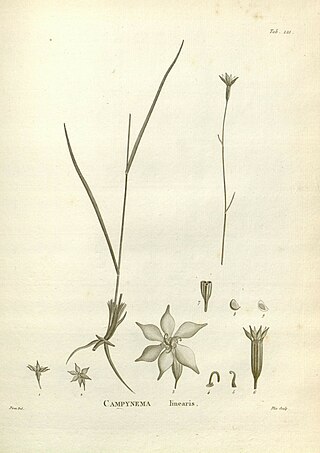
Campynema is a genus in the family Campynemataceae first described in 1805. It contains only one known species (monotypic), Campynema lineare, endemic to the island of Tasmania in Australia. Its closest relative is Campynemanthe, endemic to New Caledonia, sole other genus of the family.
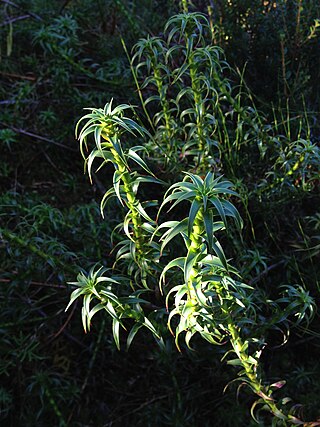
Richea gunnii, the bog candleheath or Gunns richea, is an endemic Tasmanian angiosperm. It is a dicot of the family Ericaceae and is found in Central, Western and North-east Tasmania.
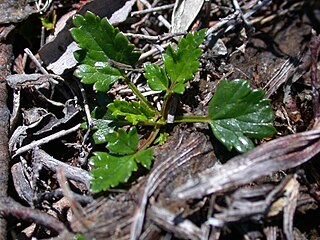
Rubus gunnianus is a species in the genus Rubus of the family Rosaceae. It is a small herb that grows in subalpine and alpine habitats above 900m throughout Tasmania, and bears edible fruit. It is commonly known as the native strawberry or Tasmanian alpine raspberry.

Actinotus moorei, the splitleaf flannelflower, is an endemic Tasmanian perennial herb in the family Apiaceae. It is found in wet ground at high elevation in Tasmania's Central Plateau as well as western and south-western mountains.

Actinotus suffocatus, the crimson flannelflower, is a small, perennial herb endemic to the Australian State of Tasmania. It is primarily found in high-elevation habitats in wet situations, except in the far south-west of the island, where it occurs down to sea level in continually moist habitats.
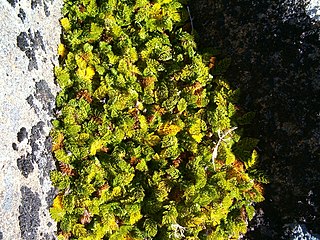
Anisotome procumbens, the mountain celery, is a small, perennial herb endemic to the Australian State of Tasmania. It is primarily found in high-elevation habitats in the west and south-west of the island.

Felicia bellidioides is a perennial plant of up to about 25 cm (10 in) high, that is assigned to the family Asteraceae. Most of the narrowly inverted egg-shaped leaves are silky hairy and in a basal rosette with no or few very narrow bracts on the stalk in the subspecies bellidioides. In the subspecies foliosa, the narrower leaves are not silky hairy but variously bristly and glandular, with more and larger bracts on the inflorescence stalk. The flowerheads sit individually on top of a long peduncle and consist of an involucre with only two worls of bracts, about twenty purplish blue ray florets, surrounding many yellow disc florets. It occurs in the Western Cape province of South Africa.

Gonocarpus teucrioides, or forest raspwort is a common flowering herb or subshrub in the Haloragaceae, or watermilfoil family. It is native to Queensland, New South Wales, Victoria and Tasmania and is widespread and abundant in the understorey of wet forests. The name raspwort refers to the rough, scabrous surface of many of the Gonocarpus species.
Monotoca glauca, known as goldy wood, is a heath family shrub endemic to Tasmania, Australia and is one of 17 described Monotoca species. It is a widespread and abundant understory species found on the margins of wet eucalypt forests and logged areas.

Trochocarpa cunninghamii is a flowering plant species of the family Ericaceae. It is commonly referred to as straggling purpleberry due to its round flattened mauve drupe fruits. This woody shrub is usually found in the understorey of rainforests and subalpine forests in the Central Plateau and western Tasmania, and is endemic to Tasmania.
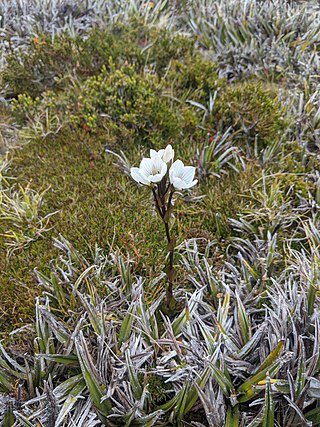
Chionogentias diemensis is a flowering herbaceous alpine plant in the family Gentianaceae, endemic to the island of Tasmania in Australia. It is commonly known as the Tasmanian mountain gentian. Chionogentias diemensis has been classified into two sub-species: the Tasmanian snow-gentian and the Ben Lomond snow-gentian.

Brachyscome bellidioides is a species of flowering plant in the family Asteraceae and is endemic to the southwest of Western Australia. It is an annual herb with linear leaves and yellow and white daisy-like flowers.




















